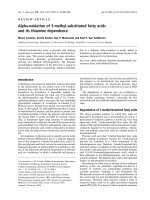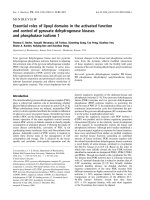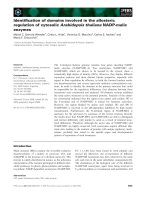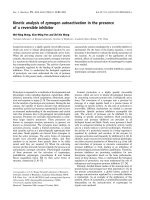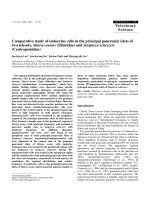Báo cáo khoa hoc:" Genetic parameters of dairy traits in the Alpine and Saanen goat breeds" pptx
Bạn đang xem bản rút gọn của tài liệu. Xem và tải ngay bản đầy đủ của tài liệu tại đây (319.46 KB, 6 trang )
Note
Genetic
parameters
of
dairy
traits
in
the
Alpine
and
Saanen
goat
breeds
Sophie
Bélichon
Eduardo
Manfredi’
Agnès
Piacère
c
a
Caprigène
France.
Agropole,
route
de
Chauvigny,
86500
Mignaloux-Beauvoir,
France
b
Station
d’amélioration
génétique
des
animaux,
Institut
national
de
la
recherche
agronomique,
BP
27,
31326
Castanet-Tolosan
cedex,
France
c
Institut
de
l’élevage,
149,
rue
de
Bercy,
75595
Paris
cedex
12,
France
(Received
4
May
1999;
accepted
16
August
1999)
Abstract -
Genetic
parameters
for
milk,
fat
and
protein
yields,
and
fat
and
protein
contents,
were
estimated
for
the
Alpine
and
Saanen
goat
breeds
using
an
animal
model.
Edited
data
included
first
lactations
of
33 431
Alpine
and
20 700
Saanen
goats
kidding
in
1996
and
1997.
Heritability
values
ranged
from
0.32
to
0.40
for
yields
and
from
0.50
to
0.60
for
solid
contents.
The
main
feature
observed
on
genetic
correlations
was
a
low
genetic
opposition
between
milk
yield
and
fat
content
(about
- 0.17)
with
a
high
genetic
association
between
fat
yields
and
fat
contents
(up
to
+0.56).
Although
the
differences
between
genetic
parameters
of
both
breeds
were
rather
low,
the
estimates
suggest
a
higher
potential
for
genetic
progress
in
protein
content
and
protein
yield
in
the
Alpine
breed,
and
a
higher
potential
for
joint
genetic
progress
in
milk
yield
and
fat
content
in
the
Saanen
breed.
©
Inra/Elsevier,
Paris
goat
/ dairy
production
/ genetic
parameters
Résumé -
Paramètres
génétiques
de
caractères
laitiers
des
races
Alpine
et
Saanen.
Les
paramètres
génétiques
des
quantités
de
lait,
de
protéines
et
de
matière
grasse
et
les
taux
protéique
et
butyreux
sont
estimés
pour
les
races
Alpine
et
Saanen
en
utilisant
un
modèle
animal.
Les
données
correspondent
aux
premières
lactations
de
33 431
(Alpine)
et
20 700
(Saanen)
chèvres
durant
les
campagnes
1996
et
1997.
Les
héritabilités
varient
de
0,32
à
0,40
pour
les
quantités
et
de
0,50
à
0,60
pour
les
taux.
Les
résultats
marquants
sont
la
corrélation
génétique
modérée
(-0,17)
entre
la
quantité
de
lait
et
le
taux
butyreux
et
la
forte
association
(0,56)
entre
la
quantité
et
le
taux
de
matières
grasses.
Si
les
différences
entre
les
paramètres
génétiques
des
deux
races
sont
faibles,
elles
suggèrent
que
le
progrès
génétique
potentiel
pour
la
quantité
et
le
taux
de
protéine
est
plus
élevé
en
race
Alpine
alors
que
l’amélioration
simultanée
de
la
quantité
de
lait
et
du
taux
butyreux
est
plus
facile
en
race
Saanen.
©
Inra/Elsevier,
Paris
caprins
/
production
laitière
/
paramètres
génétiques
*
Correspondence
and
reprints
E-mail:
1.
INTRODUCTION
Since
1985,
goat
selection
in
France
has
been
oriented
toward
an
improve-
ment
of
protein
yield
and
protein
content
(PY
and
PC,
respectively)
because
goat
milk
is
mainly
used
for
cheese
production
and
protein
content
was
a
lim-
iting
factor
in
the
highly
productive
Alpine
and
Saanen
breeds.
The
selection
programme
relies
on
the
use
of
milk
recording
and
artificial
insemination
in
an
open
nucleus
[7].
At
present,
realised
genetic
gains
for
PC
and
PY
allow
the
selection
objective
to
be
widened
by
including
fat
yield
and
fat
content
(FY
and
FC,
respectively).
The
knowledge
of
genetic
parameters
is
necessary
to
optimise
the
relative
weights
to
be
given
to
dairy
traits
in
the
new
objective.
However,
last
on-farm
estimates
available
[3]
were
obtained
using
a
sire
model
on
data
collected
between
1982
and
1985.
This
study
aims
at
updating
the
estimates
of
genetic
parameters
for
milk,
fat
and
protein
yields,
fat
and
protein
contents,
in
the
Alpine
and
Saanen
populations
using
an
animal
model.
2.
MATERIALS
AND
METHODS
2.1.
Data
First
lactation
records
of
Alpine
and
Saanen
goats
kidding
between
1
Septem-
ber
1995
and
31
August
1997
were
obtained
from
the
national
milk
recording
data
base
located
at
the
CTIG
(Processing
Centre
of
Genetic
Information).
According
to
the
current
genetic
evaluation
procedure,
yields
were
partially
corrected
for
lactation
length
(LL)
either
by
a
coefficient
equal
to
250/(60
+
LL)
for
LL
shorter
than
250
days
or
by
truncation
at
the
250th
day
when
LL
was
longer.
Data
editing
excluded
records
from
goats
who
were
over
30
months
of
age
and
records
from
herd-year
combinations
with
fewer
than
five
first
lactating
goats
or
less
than
15
%
of
daughters
sired
by
artificial
insemination
bucks.
This
last
condition
aimed
at
insuring
sufficient
genetic
connection
between
herds.
In-
deed,
when
genetic
differences
among
herds
are
suspected,
and,
therefore,
when
part
of
the
genetic
variability
may
be
confounded
with
the
environmental
herd
effect,
deleting
the
disconnected
herds
from
the
studied
samples
is
advised
[4,
10].
Pedigrees
were
traced
three
generations
back.
Samples
of
20 700
Saanen
and
33 431
Alpine
goats,
with
19 940
and
43 555
ancestors,
respectively,
were
kept
for
the
analysis.
Samples
should
be
representative
of
the
open
selection
nucleus
populations.
Their
main
characteristics
are
given
in
table
1.
2.2.
Methods
Bivariate
analyses
were
carried
out
for
all
combinations
of
the
five
dairy
traits
(ten
analyses).
The
animal
model
used
was
the
same
for
all
combinations:
where
y
is
a
vector
of
records
n
x
2
rows
(for n
recorded
goats),
/3
is
a
vector
of
fixed
effects
(herd-year,
year-age
at
kidding
and
year-month
at
kidding),
u
is
a
random
vector
of
additive
genetic
effects,
X
and
Z
are
the
corresponding
incidence
matrices
(identical
for
both
traits)
and
e
is
a
random
vector
of
residual
effects.
Expected
values
of
records
are
defined
as:
where
I
is
an
identity
matrix.
Expected
values
of
random
effects
are
assumed
to
be
null.
Covariance
matrices
are
defined
as:
where
*
denotes
direct
products,
A
is
the
relationship
matrix,
and
G
and
R are
covariance
matrices
between
both
traits
for
the
additive
genetic
and
residual
effects,
respectively.
Covariances
among
u
and
e
are
assumed
to
be
null.
For
each
year,
seven
classes
for
age
at
kidding
were
defined
(10,
11,
12,
13,
14,
15-18
and
19-30
months
old)
and
six
classes
for
month
at
kidding
were
defined
(monthly
between
January
and
April,
from
September
to
December
and
from
May
to
August).
The
covariance
components
were
estimated
using
VCE
4.2.5
by
the
multi-
variate
REML
method
based
on
analytical
gradients
!8!.
The
choice
of
bivariate
analyses
was
made
according
to
computing
facilities
available.
Consequences
of
estimating
the
covariance
components
through
bivariate
analyses
could
not
be
evaluated
but
we
verified
the
stability
of
the
multiple
variance
estimates
ob-
tained
for
each
trait,
and
also
the
eigenvalues
of
the
additive
genetic
covariance
matrix
which
was
positive-definite.
3.
RESULTS
AND
DISCUSSION
3.1.
Genetic
variability
The
estimates
of
variance
components
were
relatively
stable
throughout
the
bivariate
analyses,
with
maximum
differences
between
the
four
heritability
values
varying
between
0.2
and
0.3
%
in
most
cases,
with
extreme
values
of
0.1
%
for
FY
in
the
Alpine
breed
and
0.4
%
for
FY
in
the
Saanen
breed.
The
average
values
of
these
estimates
are
shown
in
table
IL
Heritability
estimates
ranged
from
0.32
to
0.40
for
yields
and
from
0.50
to
0.60
for
solid
contents.
For
both
yields
and
contents,
the
estimates
of
genetic
variability
and
the
corresponding
genetic
coefficient
of
variation
were
higher
for
fat
than
for
protein.
Heritability
estimates
were
also
higher
for
FY
and
FC
than
for
PY
and
PC,
respectively,
in
the
Saanen
breed,
but
not
in
the
Alpine
breed.
Heritability
estimates
were
similar
to
previous
results
for
the
Alpine
and
Saanen
breeds
[3],
although
the
samples
and
the
method
of
analysis
differed.
For
other
goat
populations
(other
breeds
or
other
environmental
conditions),
the
reported
heritabilities
for
yields
varied
from
about
0.20
[9,
12]
to
about
0.60
[6]
while
estimates
from
test-date
models
were
about
0.3
[111.
Previous
reports
and
this
study
focused
on
the
global
genetic
variability
of
dairy
traits
in
goats,
thus
including
both
polygenic
and
major
gene
effects
(asl-casein
polymorphism,
(l, 2!).
The
asl-casein
polymorphism
might
explain
part
of
the
apparent
differences
in
genetic
parameters
between
breeds.
Milk
composition
is
influenced
by
the
asl-casein
genotype
of
goats,
different
alleles
being
associated
with
different
rates
of
c!sl-casein
synthesis.
Allelic
frequencies
differ
between
breeds,
with
a
higher
frequency
of
’extreme’
alleles
in
the
Alpine
breed
[5].
Higher
genetic
variability
and
the
resulting
higher
heritability
value
for
PC
in
the
Alpine
breed
might
thus
result
from
its
more
variable
asl-casein
polymorphism.
3.2.
Correlations
between
traits
Strong
positive
correlations
between
yields
were
observed
in
both
breeds
(see
table
III),
with
genetic
correlations
between
milk
and
fat
yields
being
the
lowest
(+0.76).
The
genetic
correlation
between
fat
and
protein
contents
were
also
rather
high,
up
to
+0.61
in
the
Alpine
breed.
The
negative
correlations
between
milk
and
solid
contents,
whether
phenotypic
or
genetic,
were
moderate
for
protein
and
low
for
fat.
The
genetic
opposition
between
milk
and
FC
was
lowest
in
the
Saanen
breed
(-0.10),
and,
consequently,
the
genetic
correlation
between
FC
and
FY
was
highly
positive
in
this
breed
(+0.56).
As
in
Boichard
et
al.
!3!,
we
observed
a
low
genetic
antagonism
between
milk
yield
and
FC,
with
high
genetic
associations
between
FC
and
FY.
The
phenotypic
antagonism
and
the
genetic
association
between
FC
and
PY
or
PC
and
FY
were
low
in
both
breeds.
Although
correlations
were
similar
for
both
breeds,
point
estimates
suggest
that
the
potential
for
genetic
progress
in
PC
and
PY
might
be
somewhat
higher
in
the
Alpine
breed
and
the
potential
for
joint
progress
in
FC
and
milk
and
fat
yields
might
be
somewhat
higher
in
the
Saanen
breed:
in
the
Alpine
breed,
both
heritability
and
genetic
variability
for
PC
were
higher,
and
both
the
genetic
association
between
PC
and
PY
and
the
genetic
opposition
between
milk
yield
and
FC
were
stronger.
4.
CONCLUSION
This
study,
using
an
animal
model
and
recently
collected
data,
confirmed
previous
estimates
of
genetic
parameters
for
the
Alpine
and
Saanen
breeds.
The
low
antagonism
between
milk
yield
and
fat
content
found
in
this
study
indicates
that
losses
in
genetic
gains
for
yields
will
be
relatively
low
if
fat
content
is
included
in
the
new
selection
objective.
ACKNOWLEDGEMENTS
We
acknowledge
Caprigene
France
for
financial
support
and
the
CTIG
for
provid-
ing
the
data.
REFERENCES
[1]
Barbieri
E.,
Manfredi
E.,
Bouillon
J.,
Ricordeau
G.,
Elsen
J.M.,
Mahé
F.,
Grosclaude
F.,
Influence
of
the
polymorphism
of
the
asl-casein
on
goat
dairy
performances,
5th
World
Congr.
Genet.
Appl.
Livestock
Production
19
(1994)
344-
347.
[2]
Barbieri
M.E.,
Manfredi
E.,
Elsen
J.M.,
Ricordeau
G.,
Bouillon
J.,
Grosclaude
F.,
Mahé
M.F.,
Bibe
B.,
Influence
du
locus
de
la
caséine
asl
sur
les
per-
formances
laiti6res
et
les
paramètres
génétiques
des
chèvres
de
race
Alpine,
Genet.
Sel.
Evol.
27
(1995),
437-450.
[3]
Boichard
D.,
Bouloc
N.,
Ricordeau
G.,
Piacère
A.,
Barillet
F.,
Genetic
pa-
rameters
for
first
lactation
dairy
traits
in
the
Alpine
and
Saanen
goat
breeds,
Genet.
Sel.
Evol.
21
(1989)
205-215.
[4]
Diaz
C.,
Carabafio
M.J.,
Hernandez
D.,
Connectedness
in
genetic
parameters
estimation
and
BV
prediction,
46th
Annual
Meeting
of
the
European
Association
for
Animal
Production,
Prague,
Czech
Republic,
1995,
p.
8
(abstract).
[5]
Grosclaude
F.,
Ricordeau
G.,
Martin
P.,
Remeuf
F.,
Vassal
L.,
Bouillon
J.,
Du
gene
au
fromage :
le
polymorphisme
de
la
caséine
asl
caprine,
ses
effets,
son
evolution,
INRA
Prod.
Anim.
7
(1994)
3-19.
[6]
Kennedy
B.W., Finley
C.M.,
Bradford
G.E., Phenotypic
and
genetic
relation-
ship
between
reproduction
and
milk
production
in
goats,
J.
Dairy.
Sci.
65
(1982)
2373-2383.
[7]
Leboeuf
B.,
Manfredi
E., Boue
P.,
Piacère
A., Brice
G., Baril
G., Broqua
C.,
Humblot
P.,
Terqui
M.,
Artificial
insemination
of
dairy
goats
in
France,
Livest.
Prod.
Sci.
55
(1998)
193-203.
[8]
Neumaier
A.,
Groeneveld
E.,
Restricted
maximum
likelihood
estimation
of
covariances
in
sparse
linear
models,
Genet.
Sel.
Evol.
30
(1998)
3-26.
[9]
Rabasco
A.,
Serradilla
J.M.,
Padilla
J.A.,
Serrano
A.,
Genetic
and
non-
genetic
sources
of
variation
in
yield
and
composition
of
milk
of
Verata
goats,
Small
Rumin.
Res.
11
(1993)
151-161.
[10]
Schaef
f
er
L.R.,
Disconnectedness
and
variance
component
estimation,
Bio-
metrics 31
(1975)
969-977.
[11]
Schaeffer
L.R.,
Sullivan
B.P.,
Genetic
evaluation
of
dairy
goats
using
test
day
yields,
5th
World
Congr.
Genet.
Appl.
Livestock
Production
18
(1994)
182-185.
[12]
Wiggans
G.R.,
Animal
model
evaluation
of
dairy
goats
for
milk,
fat,
and
protein
yields
with
crossbred
animals
included,
J.
Dairy
Sci.
72
(1989)
2411-2416.

